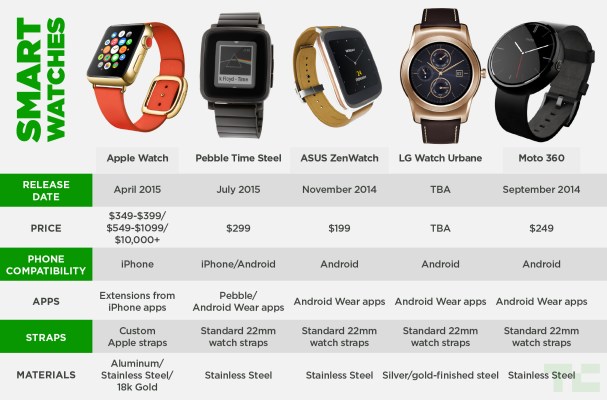After nearly half a year of suspense, we finally have all the details about the Apple Watch, including when it’ll launch, how much it’ll cost, and what the user experience will be like. That means we can take a step back and look at how it compares to the rest of the smartwatch market.
To make this a fair fight, we’ve taken the Apple Watch and put it up against premium smartwatches — other devices made from expensive-feeling metal and glass, with apps that communicate with those on your phone to keep you from spending all of your time staring at your iOS- or Android-powered pocket slate.
The Apple Watch’s Glances, a collection of relevant moments from the wearer’s favorite apps that power most of the experience, are rather similar to the Google Now cards on Android Wear, providing a bit of information and a quick way to get to the real app experience on your phone. More in-depth app experiences are also available on Android Wear (and will be on the Apple Watch come April 24), letting you do things like order a car or respond to tweets. The offerings on both sides of the iOS/Android divide will be sparse for the next few months, so right now you’re not losing out on major third-party experiences by choosing one over the other.
Both are a bit more elaborate than the sparse “Time” interface on the new Pebble Time Steel, which places important information on a timeline that stretches both forward and backward in time. The Pebble Time is also compatible with the 6,500+ apps the community made for the original Pebble, though those won’t take advantage of the new timeline interface.
Rather than give users the option to use any standard wristband (as Pebble and most Android OEMS have done), Apple is offering its own bands, with fancier Milanese and link bands serving as up-sell options in the place of storage or processing power. That’s probably more convenient for someone looking to jump right into having something that looks nice, though prior watch fanatics might miss the ability to use their own bands.
While some Android OEMs have started to push materials like stainless steel to provide a more premium heft and feel, Apple is still the only smartwatch maker with a genuine gold option for those looking for a luxury timepiece. If you’re willing to drop $10,000, the Apple Watch Edition might be for you — that, or you could buy every other smartwatch that comes out over the next few years.
Right now, it’s pretty easy to tell most people which smartwatch you should get. Hardcore iPhone user? Get an Apple Watch. Love the customization features in Android? Pick an Android Wear device on the Google Play Store. Don’t think you spend too much time on your phone? You probably don’t need either.
Notably, Pebble’s watches are your best option if you see yourself switching between mobile operating systems, since you’ll be able to make the switch without buying new gear for your wrist.

